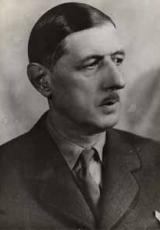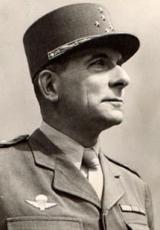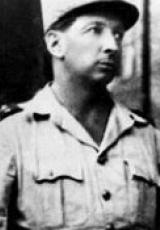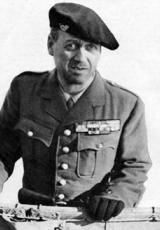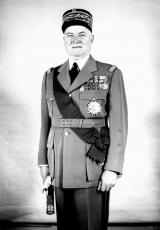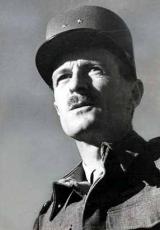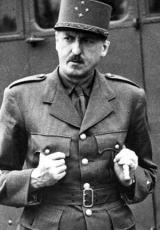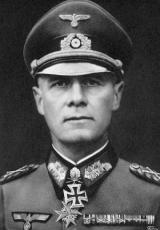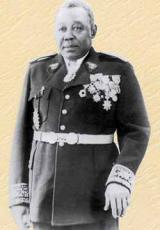The 1st Free French Division (DFL)
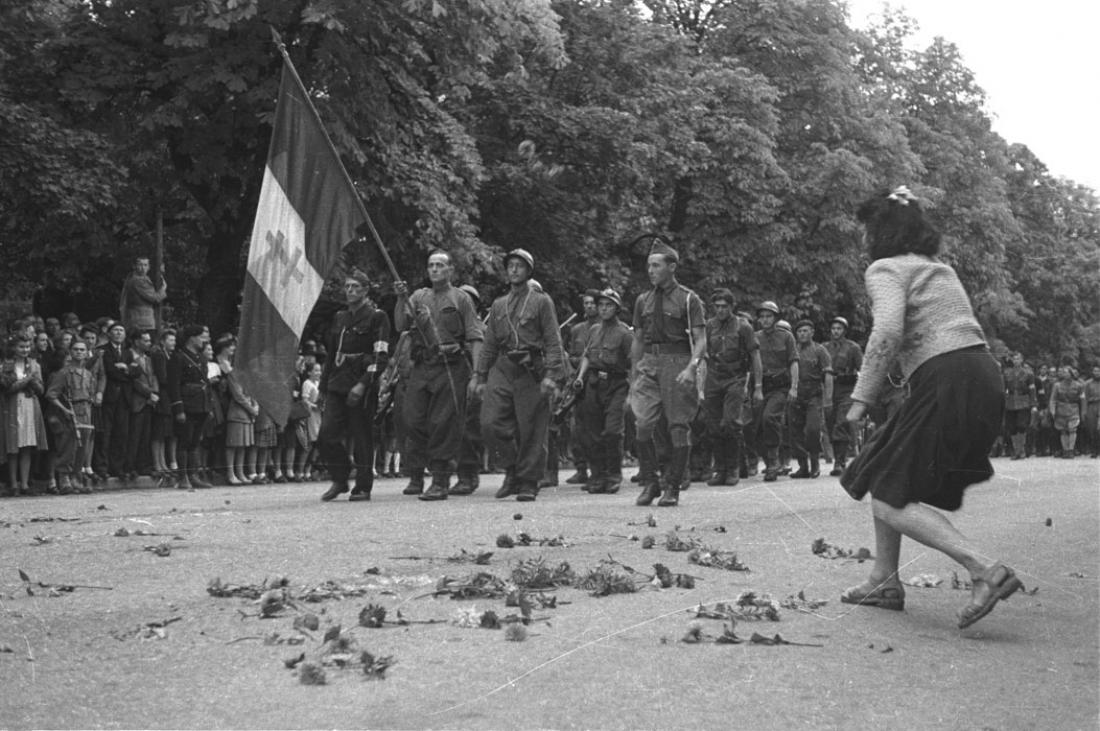
The 1st DFL (Free French Division) was officially created in June 1942, but some of the units making it up had already been fighting since the start of the war, and all were made up of men who fought constantly since 1939. They were motivated by the famous words of General de Gaulle's appeal of 18 June.
On 18 June 1940, there were more than 18,000 French soldiers in Great Britain. Some of these were soldiers who had survived Dunkirk (most had already gone back to France) but also and especially, the expeditionary corps which had come back from Norway and were staying at Trentham Park, a military regroupment camp for French soldiers. Under the orders of General Béthouart, a fellow-pupil of General de Gaulle from Saint-Cyr, this expeditionary corps had just won the glorious battle of Narvik. Unfortunately, General de Gaulle only managed to mobilise a thousand volunteers. The majority of the Expeditionary Corps returned to France, including its chief, who nonetheless made up for it later.
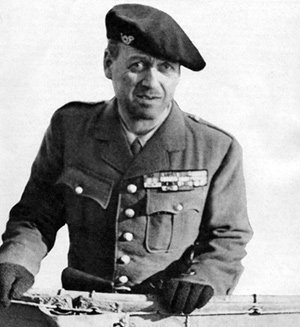
General Béthouard, commander of the Corps Expéditionnaire Français in Narvik. Source: SHD
The majority of the mustered troops consisted of the 13th Demi-Brigade of the Foreign Legion (13th DBLE) which, under the orders of its Lieutenant-Colonel Magrin-Vernerey, who would soon be famous by the name of Monclar, had just distinguished itself in the battles of Narvik, side by side with the Alpine troops against their German counterparts. Monclar, a legendary hero of the French Foreign Legion, was injured 22 times and awarded 24 times. When received by General de Gaulle, he said to him: ”My General, we have come to take your orders to fire the last rounds”.. The General replied: ”that's not the idea at all. It's about rebuilding an army and putting France back in the war”. Monclar then said to Kœnig, who at the time was a Captain: ”This General is probably a visionary, but we absolutely have to follow him.” This is how the 13th DBLE, strengthened with 7 officers, 30 non-commissioned officers and mountain infantrymen from the 6th BCA (Bataillon de Chasseurs Alpins) and a few young Bretons who had escaped from Brest came to make up the draft of what would become the 1st Free French Division.
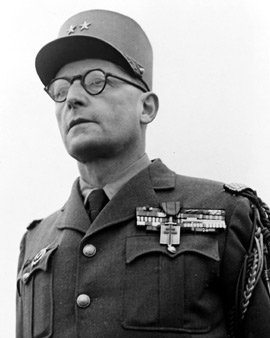
General Monclar. Source: Musée de l'Ordre de la Libération.
This first troop was later joined by several small units, notably from the Middle East. All of these forces took part in the abortive Dakar expedition, but contributed greatly to rallying French Equatorial Africa, supporting the initiative of pioneers such as Félix Eboué, and then Gabon.
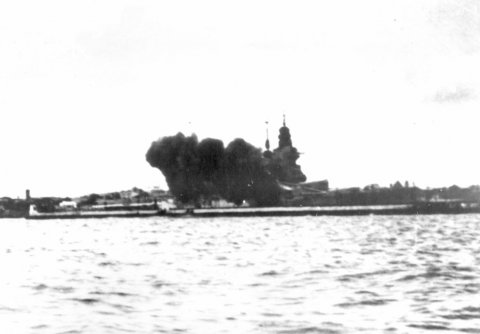
Richelieu firing in front of Dakar, September 1940. Source - DR
The 13th DBLE was then sent to East Africa. In Eritrea, it fought with distinction in the Battle of Keren in February 1941. This French victory, albeit modest in the scale of the world war, shows that the handful of brave men of Free France forced a victory a few days before that of Leclerc in Kufra. The Battle of Eritrea continued in Somalia, where French forces fought with distinction in Massawa, capturing 500 officers and 11,000 Italian marines and soldiers on 9 April 1941. The Free France troupes were engaged in tough combats in Syria, where a fratricidal struggle opposed them against Vichy forces. The 13th DBLE found itself in front of fellow Legionnaires. Two Free France officers, who were already heroic fighters, Messmer and de Bollardière, tried to stop the fratricidal combat between legionnaires, and succeeded.
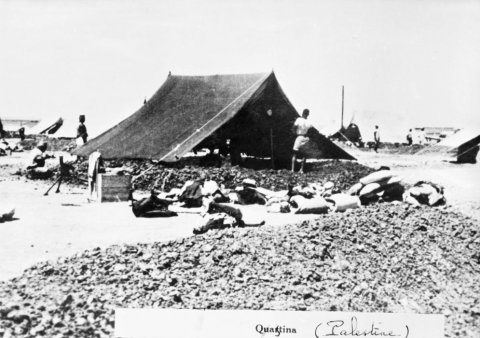
Encampment of the Bataillon de marche de l'Oubangui-Chari at the camp of Qastina, Syria (May 1941). Source: General Henri Amiel - ECPAD
During this time, French men were fighting other French men. When Monclar protested to General de Gaulle, reminding him that there must not be fighting against the French, de Gaulle retorted: ”I am the French, I am France”. These fratricidal combats were not forgotten by the Français Libres and their rivals, prisoners of a tragic conception of duty. They took place from 8 June to 12 July, killing 164 men, including 11 officers of the Français Libres, and injuring 650.
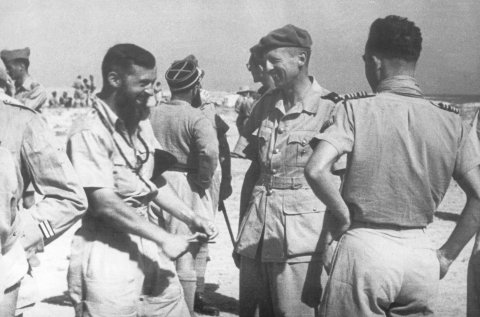
General Kœnig with his superior officers in Bir Hakeim. Source: SHD
The Forces Françaises Libres were then engaged in combats in the Libyan desert. Under the orders of General Kœnig, the 1st BFL (around 5,000 men divided into 4 infantry battalions) comprised the 13th DBLE, the Bataillon du Pacifique and a North African company. These combats culminated in the Battle of Bir Hakeim where, from 26 May to 11 June 1942, the handful of heroes from France Libre, obeying orders, delayed Rommel, contributing in a decisive manner to saving the British army in retreat. In the night from 10 to 11 June, this handful of brave men, in which General de Gaulle saw the pride of France, managed to evacuate the position, taking all their injured away.
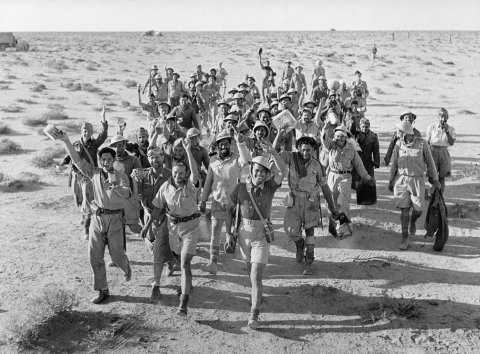
Arrival of the Français libres in British lines after Bir Hakeim. Source: Imperial War Museum.
After Bir Hakeim, the Forces Françaises Libres, the 1st Brigade and the units attached to it under the name ”colonne volante” (flying column), went on to take part in the Battle of El Alamein from 24 October 1942, thus contributing to this victory, which was the start of the reversal of the war, with the landing in North Africa and the gigantic Battle of Stalingrad.
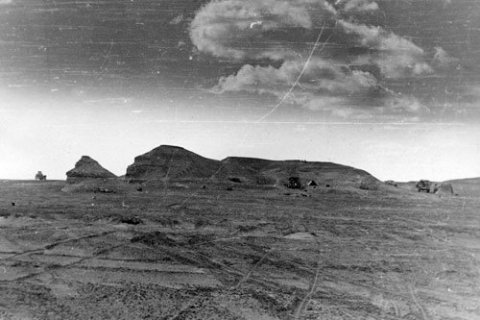
El Himeimat. View of the battlefield. Source: Musée de l'Ordre de la Libération
It was during these combats, in the 2nd Battle of El Alamein, that Lieutenant-Colonel Amilakhvari, commander of the 1st DBLE, fell. This Georgian prince, engaged in the Legion, is a symbol of grandeur, servitude and sacrificial spirit. He was killed on the second day of the battle. A quote by Monclar sums him up: ”Amilakhvari s the Legion. His military career, his enthusiasm, his deeds and acts and the Legion are one. With him, everything was great: his stature, his behaviour during times of peace and war, his ideal and his constant conflict with himself which meant that he always wanted to better himself.”
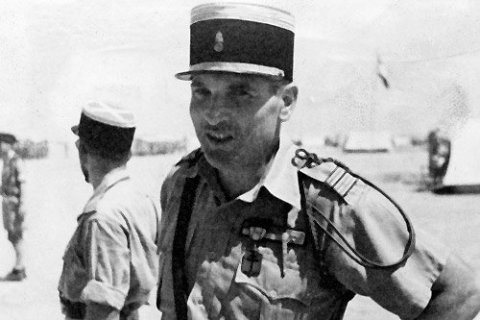
Amilakhvari in El Tahag, 10 August 1942. Source: Musée de l'Ordre de la Libération
After the victory of El Alamein on 10 November 1942, the ”flying column” played a brilliant role in pursuing the Italians and Germans. It reached Tripoli on 22 February 1943 and joined the Leclerc column on 13 March 1943. The 1st DFL took part in the extremely hard Tunisian campaign, particularly distinguishing itself south of Zaghouan in furious combats where it seized the village of Takrouna and pierced the German line of resistance. The mobile battalion No. 5 particularly stood out in these combats.
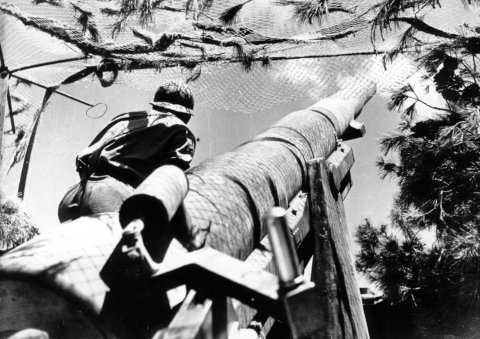
Heavy artillery in camouflage, in firing position, offensive of Zaghouan, Tunisia, May 1943 . Source: ECPAD France
The 1st Brigade of the DFL fought hard in Djebel Garci. Despite its courage, the enemy, which put up a furious fight, capitulated on 13 May in front of the entire allied forces. Let's remember that the 1st DFL, General Leclerc's L force and General Juin's French army detachment (DAF) largely contributed to this victory, reuniting at last the French army after so many divisions.
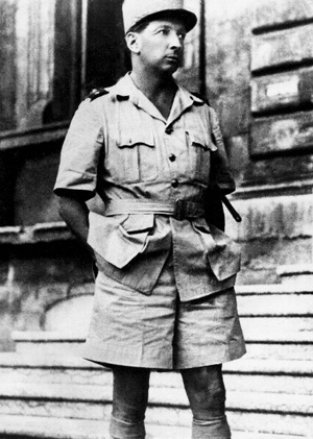
Portrait of General Diégo Brosset. Source: SHD
The 1st DFL, of which General Diego Brosset, who fought with distinction in the combats of Tunisia, had just taken command, went on to join the French Expeditionary Corps (CEF). This troop, with soldiers from the army of Africa, Algerians, Tunisians, Moroccans, troops from Black Africa, French soldiers from North Africa, French soldiers from mainland France who had often escaped via Spain after spending time in Francoist prisons, Free French from all horizons, was one of those that opened the road to Rome.
The CEF, putting an end to the harsh winter combats in which the African army had already distinguished itself, notably at Belvedere, was to become a spearhead of the Juin plan, which consisted in toppling German defences in the Liri valley by pushing through the mountains.
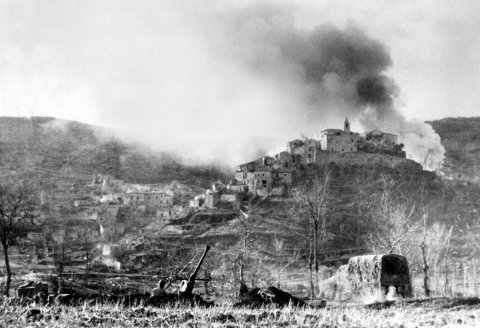
Battle of Belvedere, artillery combat in front of Acquafondata, January 1944. Source: Collection DMPA
On the day, 11 May 1944, the Garigliano was crossed by the 1st DFL. The attack was out-and-out success the following day, with the 1st Regiment of Naval Fusiliers, American tanks and those of the 8th African Armoured Regiment passing the anti-tank trench, which the previous day had blocked the advance of armoured vehicles.
Although progress was regular from there on, with the units of the division engaged and removing fortified villages transformed into military bases, the combats were very tough faced with a valorous adversary whose elite mountain and parachute troops fought relentlessly. The victory on the Garigliano was costly, with all CEF units equal in terms of self-sacrifice. The sacrifice of second lieutenant Duport, later buried in the crypt of Mont Valérien, represents for eternity the sacrifice of all of the French units in Italy.
It was the 1st DFL that penetrated, on 17 May 1944 the ”Pontecorvo Linie”, an extension of the Gustav line. It then continued on to Rome, alongside the 3rd Algerian Infantry Division of General de Monsabert.
After taking Rome, where the Bataillon d'Infanterie du Pacifique saluted General de Gaulle a few days later, the division continued the fight northwards with the 3rd DIA. The French units reached the Tuscany plains. The campaign of Italy ended for the CEF with the taking of Sienna on 3 July 1944. In 45 days of combats, the 1st DFL tallied 700 deaths and 2,100 injured men.
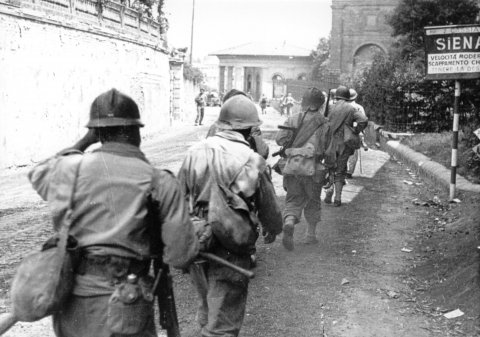
Entry of the French in Sienna, July 1944. Source: ECPAD France
The 1st DFL, like most CEF units, then became part of the B army, which would become the 1st French army. It was commanded by General de Lattre de Tassigny. Following on from the strategic talents and profound humanity of General Juin, General de Lattre de Tassigny was an extraordinary personality, with a difficult character, but incredible intuitive ability and the extreme capacity to demand the impossible thanks to a flair for handling people and an attitude of ”not giving in”.
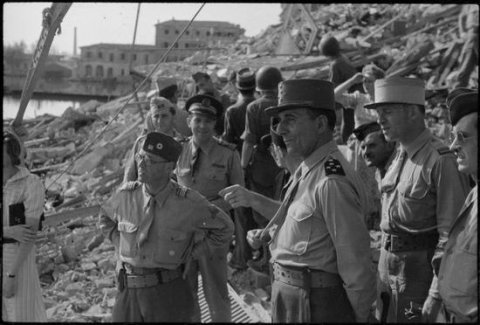
General de Lattre de Tassigny visiting the ruins of the arsenal of Toulon with French officers. Source: ECPAD
General de Lattre de Tassigny gave the 1st DFL, which landed on the beach of Cavalaire on 16 August 1944, the mission to attack the external defences of Toulon, Mont Redon and the city of Hyères. The fight began on 18 August and lasted 5 days and 5 nights. It was a fierce fight, sometimes taking place in pine forests on fire. The Français Libres penetrated the German positions up to the edges of Toulon. Among these harsh combats, the taking of the Golf Hôtel by the Bataillon d'Infanterie de Marine du Pacifique is worthy of mention. This immense concrete building took 6,000 missiles from the fleet's canons and those of the 1st Artillery Regiment resisted four attacks. Finally, the Naval units and the units from New Caledonia, under the orders of Captain Magendie, managed to force the 800 Germans fighting among the ruins to surrender. The 1st DFL did not enter Toulon because it congregated around the positions it had reached outside. It fought in the most difficult sector, seizing two fortified lines, capturing 3,600 prisoners and forcing 4,000 Germans to surrender. In this battle it suffered 229 losses and 692 injured men.
The 1st DFL then formed a group with the 1st D.B. and reached Lyon on 3 September. With the Resistance, the French units liberated the former capital of the Gauls. During the combats, General Brosset aroused the courage of his soldiers and had the pleasure of liberating Rilleux, his birthplace, with a few naval fusiliers from his division.
After incorporating into its ranks the 11th Cuirassier and the maquis of Chambarant, survivors of the battles of Vercors, the 1st DFL went on to Autun and Dijon, after destroying, with the FFI, a number of German units. The 13th DBLE once again distinguished itself in these combats.
The front stabilised in the Vosges. The 1st DFL took part in a series of difficult operations that were costly in terms of lives. General Brosset and his chief of staff were injured during a reconnaissance mission. From 10 to 14 November, operations stopped. This was to replenish fuel and also to replace some of the African and Melanesian troops who were suffering from the atmospheric conditions. These soldiers were replaced by soldiers from the French mainland engaged during the victorious advance from Provence to the Vosges.
The battle for Mulhouse and Belfort began on 14 November. The 1st DFL, which was part of the 2nd army corps, opened the route from Champagney to Giromagny, which it reached on 22 November. Alsace and the Doller valley were conquered. Operations were very difficult in very harsh atmospheric conditions: flooding rivers, bridges often destroyed, etc.
During these combats, on 20 November 1944, General Brosset was accidentally killed while driving his car on a tour of inspection. A legendary figure had gone, regretted by all of his men.
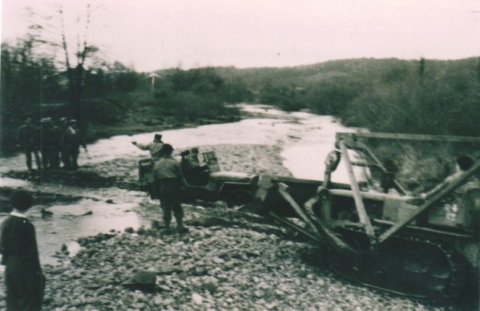
General Brosset crosses the Rhine in Champagney on 19 November 1944, slightly downstream of the collapsed bridge. The village has just been liberated. Source: Photo: Yvette Mathey from Champagney
Born in 1898, Diego Brosset joined a battalion of mountain infantrymen at the age of 17 in 1915. He stood out in this elite troop and when World War 1 was over, he was an adjutant. He stayed in the army and joined the military school of Saint Maixent and chose colonial infantry.
He joined the camel cavalry and then worked on indigenous affairs. On a mission in Colombia during the 1940 Armistice, he immediately rallied on the side of General de Gaulle by joining him in London. He was sent to Syria, and was successively chief of staff of General Catroux, then commander of a motorised infantry brigade. In 1943 he succeeded General Koenig at the head of the 1st DFL, which he led from Libya to the Rhine, passing by Tunisia and Italy.
This emblematic figure of France Libre deserves every homage for his energy, his joie de vivre, his courage and his non-conformity (he took Eve Curie in his staff and the actor Jean Pierre Aumont). He had a passion for all sports, in particular swimming, and always pushed back the limits. He was also an educated man who spoke four languages and was passionate about literature.
His death plummeted the 1st DFL into dismay. He was the perfect incarnation of the DFL and still today in the memory of its men, the 1st DFL is the ”Brosset division”, like the 2nd DB is the ”Leclerc division”.
Colonel Garbay, the most senior in grade, took over command. He became a General and directed the division in winter 1944, which was witness, during the German offensive in Alsace, to the bitter defence of Strasbourg. The 1st DFL took part notably in Obenheim, where the BM 24 of commander Coffinier was entirely destroyed after relentless resistance: only three men managed to come back, including one of General de Gaulle's nephews. The SS later saluted the French men who died in combat. General Leclerc warmly congratulated his peer, Garbay: ”Well done old chap. On balance, the 1st DFL would probably have saved Strasbourg after the 2nd D.B. had conquered it. I hope it didn't cost you too dear. Congratulate everyone on our behalf, and don't hesitate to make the truth known. ”.
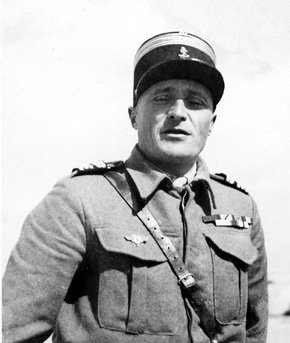
Colonel Garbay. Source: Musée de l'Ordre de la Libération.
This ”truth” is that the losses of the 1st DFL were high in the week from 1 to 7 January 1945: 1,337 deaths and 400 ill soldiers, notably with frostbite on their feet due to the extreme temperatures, with averages of -15° to -20° during the day.
On 3 March 1945, the 1st DFL was sent to the front of the Alps and joined the Alps army detachment. The latter, commanded by General Doyen, faced, after the liberation of the Alpine region, a resolved enemy, sitting on the high mountain valleys from which it had all access points to Italy. By now there were not many German and Italian forces still loyal to Mussolini, but those that were included elite units, Alpine troops such as the 5th Gebirgsjäger and the 34th infantry division, as well as the Italian Monte Rosa division. In France, although a few American troops were still in place, most of the Alps army detachment consisted of troops from the 27th Alpine division, little by little reinforced with Alpine infantry regiments from the Lanusse grouping, and the 99th and 141st infantry regiments and the 69th mountain artillery regiment.
The 1st DFL reinforced these troops. It is also necessary to emphasise that some of the units, as we saw earlier, had already fought with the Alpines during the Battle of Narvik. They ended the war as they started it, in the snow, after having fought in the desert. So, the 1st DFL played a glorious part in the combats on the front of the Alps, notably in the Battle of Authion where, alongside the Alpines, the Français Libres fought in summits at 2,000 m. These combats, now mostly forgotten, allowed this army to descend into Italy and to justify annexation by France, during the peace treaty with Italy, of the regions of Tende and Brigue, formerly within the Duchy of Savoy and the county of Nice.
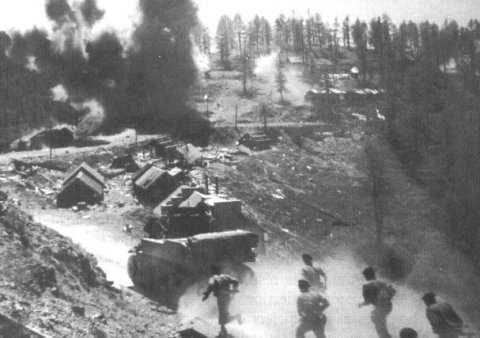
Naval Fusiliers in the Authion mountains. Source : http://www.francaislibres.net/
The glory of the 1st DFL largely deserves the homage paid by General de Gaulle to this elite unit: ”...It is one of the finest pieces of our history. It is a rock which the waves of time can never destroy. It is forever a challenge for all those who doubt France”.
Personalities
Related articles
- Aux origines de la France Libre
- Who were the Free French?
- The Norwegian campaign (9 April - 7 June 1940)
- Rallying the Empire to Free France
- KOUFRA, début d'une épopée
- The Battle of Bir Hakeim
- Battle of El Alamein, October-November 1942
- La campagne de Tunisie
- La campagne d'Italie (3 septembre 1943-2 mai 1945)
- Les Français dans la campagne d'Italie (1943-1944)
- Provence août 1944
- Le Vercors
- The overseas soldiers in the Second World War


